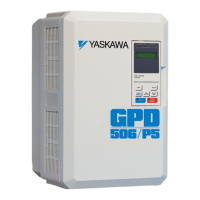1-2 GPD 506/P5 and Serial Communications
Introduction to GPD 506/P5 Modbus RTU Communication
This manual describes the set-up and protocol for Modbus Communication. The GPD 506 offers
RS-232 C/D serial communication as standard, and RS-485 as an option.
The Modbus RTU protocol requires that the controller communicates using a master-slave
technique, in which only one device (the master) can initiate transactions. The other devices (the
slaves) respond by supplying the requested data to the master, or by taking the action requested.
The GPD 506 drive must act in the slave mode.
A complete understanding of drive programming and operation is required before attempting
serial communication operation. A full discussion of programming and operation is covered in the
GPD 506 technical manual - TM 4506.
GPD 506 / Modbus RTU Specifications
The data that may be sent or received from the drive consists of:
-Run Command
-Frequency Reference
-Fault Contents
-Drive Status
-Drive Parameter Settings
The following table illustrates whether the serial communication specifications are fixed or user
selectable. If the specification is fixed, the fixed value is shown in the last column. If the
specification is selectable, the range of allowed values is shown in the last column.
Communication Specification Fixed or Selectable Range
Baud Rate Selectable 2400, 4800, or 9600 bps
Data Bit Fixed 8
Parity Selectable None, Even, or Odd
Stop Bit Fixed 1
Nodes RS-232 C/D point-to-point only
Nodes Selectable for RS-485 maximum of 31 nodes
Standard RS-232 C/D Serial Communication
The GPD506 drive offers RS-232 C/D serial communications as a standard feature of the drive.
RS-232 C/D has a maximum transmission distance of 50 feet. RS-232 C/D allows point-to-point
communications only. The specifications for wiring and pin outs for RS-232 C/D are presented
in Chapter 2.

